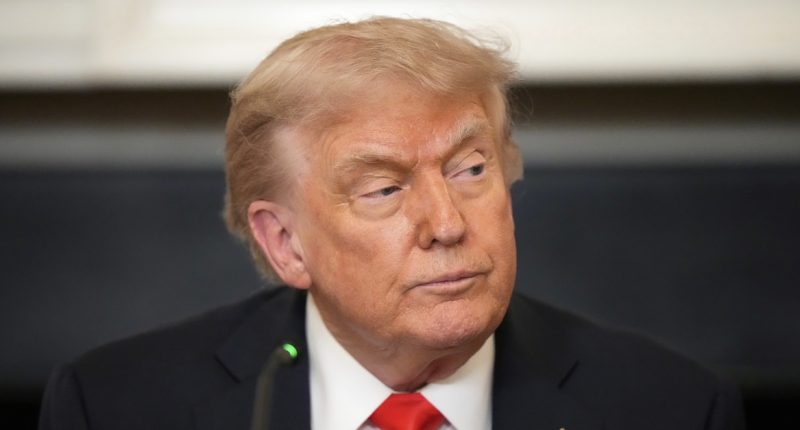Share this @internewscast.com
President Donald Trump attends a meeting with the Fraternal Order of Police in the State Dining Room of the White House on Thursday, June 5, 2025, in Washington (AP Photo/Alex Brandon).
The Trump administration experienced a setback in a California federal court on Tuesday when numerous new cities and counties joined litigation aimed at safeguarding sanctuary jurisdictions from funding cuts.
Earlier this year, plaintiffs filed a lawsuit against President Donald Trump and others concerning two executive orders titled “Protecting the American People Against Invasion” and “Ending Taxpayer Subsidization of Open Borders.” Issued in January and February, these orders instructed agencies to explore ways to withhold federal funding from jurisdictions that opposed the administration’s anti-immigration policies.
Following the lawsuit’s filing, the plaintiffs pursued and obtained a preliminary injunction. They further requested a clarifying order after subsequent executive orders were issued targeting sanctuary jurisdictions in April, a request which was also granted.
The court later issued an additional order detailing why the plaintiffs stood a strong chance of succeeding and granted several judicial notice requests that integrated agency policy memos into the litigation process.
In sum, both the drumbeats and the drips — the major and minor asks — have been steadily falling in favor of the plaintiffs in the case.
In a recent move, plaintiffs requested Senior U.S. District Judge William Orrick, appointed by Barack Obama, to add 34 more jurisdictions to the lawsuit, extend existing injunctive protections to them, and accelerate the briefing on the matter. The court sided against the Trump administration, marking another loss for the defendants.
In an 18-page order, Orrick found that amending the pleadings does not actually change much at the present stage of the litigation.
“Defendants oppose amendment, arguing that it is futile and prejudicial,” Orrick writes. “Defendants’ arguments are unpersuasive. Leave to amend should be granted liberally. While motion practice and discovery may well change the shape of this litigation, that is no reason to deny amendment. The addition of new plaintiffs, who bring the same claims and allege that they have suffered similar injury, does not unduly prejudice the defendants, new or old.”
In addition to adding dozens of new plaintiffs to the lawsuit, the court signed off on adding two new defendants – bringing that total up to nine – as well as additional allegations “pertaining to executive actions taken” by the Trump administration since the injunction was issued.
The U.S. Department of Justice, for its part, argued savings clauses in the executive orders keep them all within the realm of constitutionality and valid under the Administrative Procedure Act (APA), the federal statute governing agency actions and legal challenges to such actions.
The court found those arguments unconvincing, less than fully fleshed-out, and simply retreads of previously unsuccessful efforts.
“Defendants’ arguments regarding the plausibility of the plaintiffs’ claims are no more convincing now than they were at the preliminary injunction stage,” the order goes on. “As the plaintiffs point out in [their reply], the defendants assert the same positions that they took with respect to [an earlier version of the lawsuit], insisting that the challenged Executive Orders are not unconstitutional.”
And, while the government promised to “elaborate” on its savings clause argument in a forthcoming motion to dismiss, the judge cast doubts on its effectiveness – at least for now.
“The clear and specific language in the challenged sections of those Executive Orders call for freezing or pausing all federal funds to sanctuary jurisdictions,” the order continues. “The inclusion of a savings clause alongside language like this does not insulate the challenged executive action from review or make the plaintiffs’ claims futile.”
The court’s cold water-throwing takes stock, at length, of an argument advanced by DOJ attorneys which sought to use an unlikely source – a concurrence by U.S. Supreme Court Justice Sonia Sotomayor.
In a July 8 ruling, the nation’s high court gave the Trump administration the go-ahead to resume ambitious plans to reorganize the federal government and mass-fire federal workers in line with an executive order. While Justice Ketanji Brown Jackson harshly upbraided her colleagues and disagreed with the result, Sotomayor partially joined the dissent but agreed with the result due to language directing such reorganizations “consistent with applicable law.”
Orrick says the DOJ’s reliance here is inapposite.
From the order, at length:
Justice Sotomayor’s concurrence applies to the Executive Order at issue in that case, which involves a different context, different directives and different language than the Executive Orders at issue here. As the Ninth Circuit explained in San Francisco, an Executive Order’s savings clause “does not and cannot override its meaning,” not where the Executive Order unambiguously commands action and that action is not “consistent with applicable law.” Here, the challenged Executive Orders command federal agencies to pause or freeze all funding to sanctuary jurisdictions pending their compliance with federal immigration law. I am bound by the San Francisco precedent. The mere inclusion of a boilerplate savings clause does not insulate the challenged Executive Orders from review at this time.
The government also complained that allowing new plaintiffs “would result in unwieldy, behemoth, and never-ending litigation.”
Again, the court disagreed.
“At least at this stage, allowing 34 more jurisdictions to enter this case and two new defendants will not unduly delay it or render it unwieldy,” Orrick goes on. “It would appear, instead, that judicial economy will be enhanced by their joinder—if all the plaintiffs were severed, there would be numerous district courts engaged in the same analysis around the country while the parties on each side utilized a ‘whack a mole’ strategy to protect their interests…In sum, amendment would not be futile.”
Finally, the DOJ argued the inclusion of different plaintiffs would be prejudicial. But the judge rubbished those concerns out of hand.
“Defendants offer no deeper insight (nor precedential support) for how the additional parties will prejudice them other than to contend that it will create more work,” the order continues. “That is not prejudice.”














